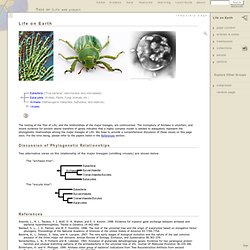

Botany online - The Internet Hypertextbook: Contents. 7.014 Introductory Biology. NMNH IZ Features - leeches. Cymothoa exigua. Cymothoa exigua, or the tongue-eating louse, is a parasitic crustacean of the family Cymothoidae.

This parasite enters fish through the gills, and then attaches itself to the fish's tongue. The female attaches to the tongue and the male attaches on the gill arches beneath and behind the female. Females are 8–29 millimetres (0.3–1.1 in) long and 4–14 mm (0.16–0.55 in) in maximum width. Males are approximately 7.5–15 mm (0.3–0.6 in) long and 3–7 mm (0.12–0.28 in) wide.[1] The parasite destroys the fish's tongue, and then attaches itself to the stub of what was once its tongue and becomes the fish's new tongue.[2] Behavior[edit] Cymothoa exigua extracts blood through the claws on its front, causing the tongue to atrophy from lack of blood. Distribution[edit] Cymothoa exigua is quite widespread. In 2005, a red snapper parasitised by what could be Cymothoa exigua was discovered in the United Kingdom.
Reproduction[edit] Not much is known about the life cycle of C. exigua. Popular Media[edit] From prokaryotes to eukaryotes. From prokaryotes to eukaryotes The complex eukaryotic cell ushered in a whole new era for life on Earth, because these cells evolved into multicellular organisms.

But how did the eukaryotic cell itself evolve? How did a humble bacterium make this evolutionary leap from a simple prokaryotic cell to a more complex eukaryotic cell? The answer seems to be symbiosis — in other words, teamwork. Evidence supports the idea that eukaryotic cells are actually the descendents of separate prokaryotic cells that joined together in a symbiotic union. Life on Earth. References Aravind, L., R.

L. Tatusov, Y. I. Wolf, D. Baldauf, S. Becerra, A., L. Benachenhou, L. Brinkmann, H. and H. Brocks, J. Brown, J. Brown, J. Brown, J. Caetano-Anolles, G. 2002. 3.24.2005 - Octopuses occasionally stroll around on two arms, UC Berkeley biologists report. UC Berkeley Press Release Octopuses occasionally stroll around on two arms, UC Berkeley biologists report By Robert Sanders, Media Relations | 24 March 2005 BERKELEY – Two species of tropical octopus have evolved a neat trick to avoid predators - they lift up six of their arms and walk backward on the other two.

This first report of bipedal behavior in octopuses, written by University of California, Berkeley, researchers, will be published in the March 25 issue of Science. When walking, these octopuses use the outer halves of their two back arms like tank treads, alternately laying down a sucker edge and rolling it along the ground. UC Berkeley graduate student Crissy Huffard clocked the two-legged speed of one coconut octopus at two and a half inches per second, while a second individual zoomed along, backwards, at five and a half inches per second. Not so when walking. "This bipedal behavior allows them to get away and remain cryptic," said Huffard. 06.06.2007 - Agonized pose tells of dinosaur death throes. UC Berkeley Press Release Agonized pose tells of dinosaur death throes By Robert Sanders, Media Relations | 06 June 2007 BERKELEY – The peculiar pose of many fossilized dinosaurs, with wide-open mouth, head thrown back and recurved tail, likely resulted from the agonized death throes typical of brain damage and asphyxiation, according to two paleontologists.

A classic example of the posture, which has puzzled paleontologists for ages, is the 150 million-year-old Archaeopteryx, the first-known example of a feathered dinosaur and the proposed link between dinosaurs and present-day birds. "Virtually all articulated specimens of Archaeopteryx are in this posture, exhibiting a classic pose of head thrown back, jaws open, back and tail reflexed backward and limbs contracted," said Kevin Padian, professor of integrative biology and curator in the Museum of Paleontology at the University of California, Berkeley. Mitowheel.